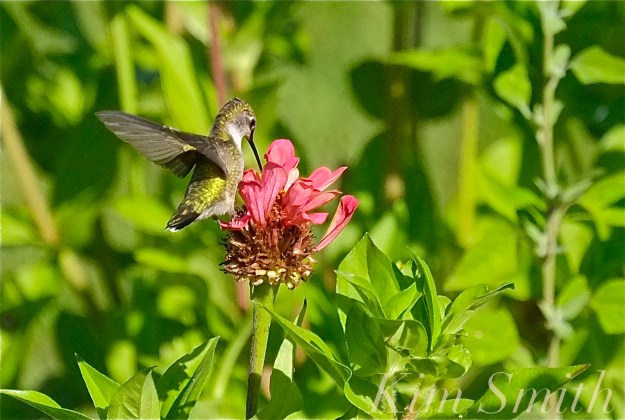 A Ruby-throated Hummingbird’s diet is comprised of nectar and insects. In early spring there isn’t much to offer in the way of flowering sustenance or insects. Around the first of April, we take our feeders out of storage, give them a good wash with vinegar, soap, and water, fill with a sugar/water mixture, and hang them throughout the garden.
A Ruby-throated Hummingbird’s diet is comprised of nectar and insects. In early spring there isn’t much to offer in the way of flowering sustenance or insects. Around the first of April, we take our feeders out of storage, give them a good wash with vinegar, soap, and water, fill with a sugar/water mixture, and hang them throughout the garden.
Sugar water recipe: 4 parts water to 1 part sugar. Stir to dissolve thoroughly. Never add red dye or replace the sugar with honey. Provide fresh sugar/water every 4 – 5 days. The water will need to be changed more frequently in hot humid weather. Discard water that has black mold and clean feeders throughly.
You can keep hummingbirds coming to your garden throughout the growing season by providing nectar-rich tubular-shaped flora in shades of primarily red, orange, and yellow (although I see them drinking nectar from a rainbow of hues), along with flowers comprised of small florets that attract small insects (the florets at the center of a zinnia plant, for example).
If I could only grow one plant to attract the Ruby-throats, it would be honeysuckle. Not the wonderfully fragrant, but highly invasive Japanese honeysuckle, but our beautiful native Trumpet Honeysuckle (Lonicera sempervirens) that flowers in an array of warm-hued shades of Spanish orange (‘John Clayton’), deep ruby red (‘Major Wheeler’), and my very favorite, the two-toned orange and red ‘Dropmore Scarlet.’
 Lonicera sempervirens ‘Dropmore Scarlet’
Lonicera sempervirens ‘Dropmore Scarlet’
Trumpet Honeysuckle has myriad uses in the landscape. Cultivate to create vertical layers, in a small garden especially. Plant Lonicera sempervirens to cover an arbor, alongside a porch pillar or to weave through trelliage. Allow it to clamber over an eyesore or down an embankment. Plant at least one near the primary paths of the garden so that you can enjoy the hummingbirds that are drawn to the nectar-rich blossoms. We practically bump into our hummingbirds as they are making their daily rounds through the garden flora.
Did you know Ruby-throated Hummingbirds make a funny squeaky sound? I began to take notice of their presence in our garden, when at my office desk one afternoon in late summer, with windows open wide, I heard very faint, mouse-like squeaks. Glancing up from my work, fully expecting to see a mouse, and was instead delighted to discover a female Ruby-throated Hummingbird outside my office window, nectaring at the vines. Trumpet Honeysuckle not only provides nectar for the hummingbirds, it also offers shelter and succulent berries for a host of birds.
The following are several posts written over the years to help readers attract Ruby-throated Hummingbirds to their homes and gardens.
Three Hummingbirds in Our Garden Today!
Ruby-throated Hummingbird
A Hummingbird’s Perspective
Where to Place YOur Hummingbird Feeders
Harbingers of spring, flowering Quince, both the vivid ‘Texas Scarlet’ and less common Chaenomeles speciosa ‘Toyo-Nishiki’ are wonderfully attractive to hummingbirds.
A question written awhile back from my friend Kate:
Where do you place the feeders? Are they okay out in the open and, if so, do the hummingbirds become too nervous to feed if they can be seen by birds of prey?
Ruby-throated Hummingbirds prefer feeding at a station where they perch and observe the landscape, and then zoom in. Hang feeders on the lower limbs of trees and on shepherd’s hooks close to shrubs and above perennial wildflowers, about five to six feet off the ground. I haven’t read or heard too much about birds of prey in regard to hummingbirds; they move too fast, however, bluejays are said to attack nestlings. House cats and praying mantis pose a more serious threat to hummingbirds.
Eye-catching Red Riding Hood tulips, although not a good source of nectar, will attract by the sheer brilliance of their color, are a wonderful species tulip that reliably returns year after year, and multiplies. We plant Red Riding Hood tulips beneath the boughs of flowering and fruiting trees and shrubs, in hopes, that they too will lure the hummingbirds to our garden during their northward migration. And then, again with high hopes, that the hummingbirds will nest in our garden. For the past nine years, it has been our great good fortune to host throughout the nesting season female Ruby-throated Hummingbirds and then later in the summer, their fledglings!
Mallows provide nectar in later summer and Red Riding Hood tulips attracts by their color. Both are perennial.
 The later blooming annual vine, Cardinal Climber, provides nectar for southward migrating RT Hummingbirds.
The later blooming annual vine, Cardinal Climber, provides nectar for southward migrating RT Hummingbirds.
A chance encounter with the brilliant emerald green feathered female Ruby-throated Hummingbird, drinking nectar from the Wild Sweet William growing in the sand at the base of the Welcome Good Harbor Beach sign.
She is drinking nectar from the wildflower Saponaria officinalis. The plant’s many common names include Soapwort, Bouncing-bet, and Wild Sweet William. The name Soapwort stems from its old fashioned use in soap making. The leaves contain saponin, which was used to make a mild liquid soap, gentle enough for washing fine textiles.
Saponaria blooms during the summertime. Although introduced from Eurasia, you can find this wildflower growing in every state of the continental US.
The hummingbird in the clip is a female. She lacks the brilliant red-feathered throat patch, or gorget, of the male. Ruby-throated Hummingbirds are all around us, you just have to know what to plant to bring them to your garden. Mostly they eat tiny insects but if you plant their favorite nectar-providing plants, they will come!
Like this:
Like Loading...

 Japanese flowering quince ‘Toyo-nishiki.’
Japanese flowering quince ‘Toyo-nishiki.’




















